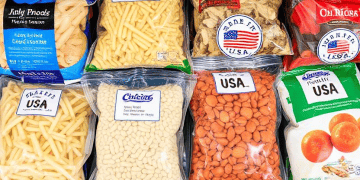WASHINGTON — On April 2, the White House announced a series of new tariffs, which could increase the cost of a range of ingredients and finished food products in the United States. These include items such as coffee, chocolate, cheese, and olive oil.
The most significant change is the introduction of a universal 10% minimum tariff on all imports, effective April 5. This measure affects food and agricultural products, among other goods. In addition, the White House unveiled retaliatory tariffs targeting more than 50 countries, with rates ranging from 10% to 49%.
White House officials clarified that these new tariffs will stack on top of existing ones. For instance, China, the United States’ third-largest trading partner in 2024, will face a new 34% tariff on imports, combined with an additional 20% tariff that has been in place since the beginning of President Trump’s second term. This will result in a total levy of 54% on Chinese goods.
Other countries also face significant increases: Japan will see a 24% tariff, while the European Union will face a 20% tariff. Vietnam, South Korea, and India are also among the countries affected, with tariffs set at 46%, 25%, and 26%, respectively.
Leslie Sarasin, CEO of FMI – The Food Industry Association, expressed concerns over the potential impact of these new tariffs on prices, household budgets, and the competitiveness of American companies. “The uncertainty and inflationary pressures created by reciprocal tariffs are a major worry for American consumers and our food industry member companies,” Sarasin said.
Notably, fresh fruit and vegetable imports from Mexico and Canada are exempt from the new tariffs. Both nations remain crucial trade partners for the United States under the United States-Mexico-Canada Agreement (USMCA), which continues to shield most food and agricultural products from additional tariffs.
The International Fresh Produce Association (IFPA) welcomed the decision to maintain the exemption for fresh produce, which is vital for maintaining a consistent supply of items such as bananas, tomatoes, and avocados. Cathy Burns, CEO of IFPA, stated, “The global trade of fresh produce is essential to the health and well-being of people in every nation.”
However, coffee and coffee products are no longer exempt from tariffs under the USMCA. Countries such as Brazil, Vietnam, and Colombia, among others, now face tariffs ranging from 10% to 46%. The United States has no significant domestic coffee production, so these changes could have a direct impact on coffee prices.
Similarly, the new tariffs will affect cocoa producers, with countries like the Ivory Coast, Ghana, and Indonesia facing increased levies on cocoa imports. Finished chocolate products from the European Union, Switzerland, and the United Kingdom will also be subject to additional tariffs.
Other food products, including olive oil, cheese, and alcoholic beverages, particularly wine and beer from European nations, will see higher prices. The EU was the largest export market for US food and agricultural goods in 2024, and the new tariffs could lead to retaliatory measures from other countries, affecting US exports.
The European Union is a significant buyer of US tree nuts, soybeans, and alcoholic beverages, and any trade disruptions could negatively impact US producers. On the other hand, US soybean growers may face a shift in demand to Brazil, the world’s largest soybean producer, as trade relations are influenced by these tariff changes.
While the tariffs may raise input costs for food producers, particularly those reliant on imported ingredients, some industry representatives caution that the broader economic consequences could be negative. Tom Madrecki, Vice President of Supply Chain Resiliency at the Consumer Brands Association, noted that critical ingredients and inputs that are not available domestically would still need to be imported, which could drive up costs for food manufacturers and limit consumer access to affordable products.
The new tariffs reflect ongoing shifts in the US trade policy under the “America First” agenda, with significant implications for global food trade and the cost of living in the United States.
Explore top supply chain logistics news at The Supply Chain Report. Interested in international trade? Visit ADAMftd.com for free tools.
#USTariffs #FoodProducers #TradeImpact #AgriculturalExports #USTradePolicy #TariffChallenges #GlobalSupplyChain














